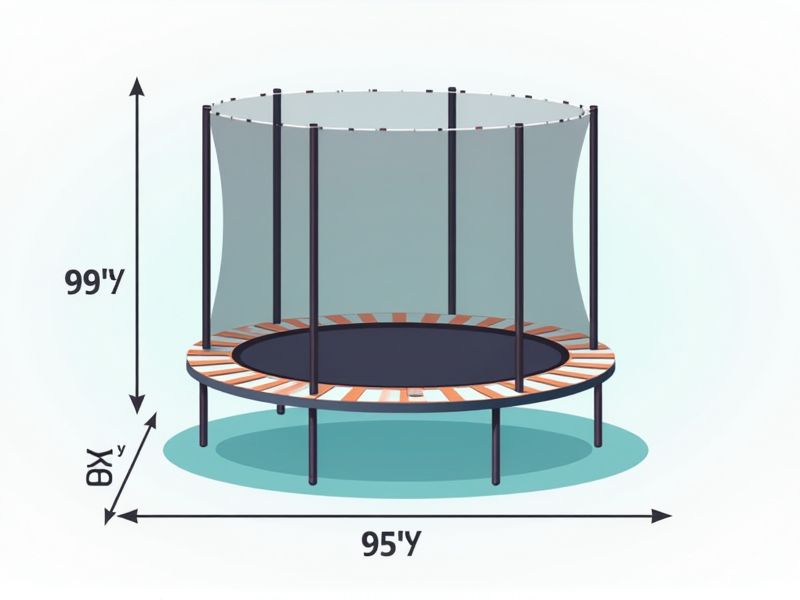
When choosing a trampoline, knowing the standard dimensions can help you select the best fit for your space and needs. Most round trampolines range from 8 feet to 16 feet in diameter, with the 12-foot size being the most common for backyard use. Rectangular trampolines, often used for gymnastics, typically measure around 7 by 10 feet for smaller models and up to 10 by 17 feet for larger versions. Always make sure to leave at least 2-3 feet of clearance around the trampoline for safety and easy access.
Safety Standards
Safety standards for trampolines are crucial, with organizations like ASTM International establishing guidelines to minimize injury risks. These standards include specifications for padding around the frame, netting to prevent falls, and appropriate weight limits, typically around 250 to 400 pounds for recreational use. Manufacturers must conduct rigorous testing, ensuring that their products meet safety criteria before being marketed. When selecting a trampoline, prioritize those certified by recognized safety organizations to ensure a secure and enjoyable experience.
Weight Capacity
Trampolines typically have a weight capacity ranging from 200 to 1,500 pounds, depending on the model and construction quality. Standard backyard trampolines usually support between 250 to 400 pounds, accommodating multiple jumpers safely. It's essential to consider the combined weight of all users and any added equipment, like safety nets or pads, when selecting a trampoline. Ensuring that your trampoline meets or exceeds safety standards related to weight capacity can significantly reduce the risk of injury during use.
Frame Size
The standard trampoline frame size typically ranges from 10 to 15 feet in diameter for residential models, with a weight capacity averaging between 200 to 400 pounds. A larger frame size enhances stability and provides a better jumping experience, suitable for multiple users. For safety, ensure that the frame is made from galvanized steel, which prevents rust and prolongs lifespan. When selecting a trampoline, consider both the frame size and the intended use to optimize performance and safety for your family.
Jumping Mat Size
The jumping mat size is a critical aspect of trampoline standards, impacting both safety and performance. Typically, commercial trampolines feature a jumping mat measuring between 10 to 14 feet in diameter, allowing for optimal bounce and user experience. For recreational trampolines, sizes can vary from 8 to 12 feet, but a larger mat offers better stability and safety for users. Ensure your trampoline's mat adheres to these guidelines for both fun and secure jumping experiences.
Spring Count
When evaluating the standards of a trampoline, the spring count plays a crucial role in determining performance and safety. High-quality trampolines typically feature between 72 and 96 springs, which facilitate improved bounce and stability. A greater number of springs generally yields a more responsive jumping experience, as each spring distributes weight evenly and minimizes wear. For your trampoline selection, consider both the spring count and the spring length, as these factors directly influence bounce dynamics and user enjoyment.
Enclosure Height
The enclosure height of a trampoline is crucial for ensuring safety, with most standards recommending a height of at least 1.5 meters (approximately 5 feet) to prevent falls. This protective barrier minimizes the risk of injury by keeping jumpers securely contained within the trampoline area. A higher enclosure provides additional security, especially for children, who may not be aware of their surroundings while jumping. When selecting a trampoline, ensure that the enclosure not only meets safety regulations but also suits your specific needs, such as usage and jumpers' ages.
Trampoline Shape
The standard shape of a trampoline significantly affects both performance and safety. Circular trampolines, commonly found in backyards, offer uniform bounce and stability, while rectangular trampolines, often used in professional settings, provide a more controlled and versatile jumping experience. To maximize safety, a typical backyard trampoline should have a diameter of at least 8 to 14 feet, with added safety features like net enclosures to prevent falls. Understanding the pros and cons of various shapes can help you choose the best trampoline to meet your needs.
Pad Thickness
When selecting a trampoline, Pad thickness is a critical factor influencing safety and durability. Most high-quality trampolines feature pads ranging from 0.5 inches to 1 inch in thickness, providing essential cushioning to protect users from accidental falls. A thicker pad effectively absorbs impact, reducing the risk of injury while enhancing the overall bouncing experience. Investing in trampolines with adequate Pad thickness ensures a safer environment for your family and prolongs the lifespan of the equipment.
Leg Configuration
The standard of trampoline leg configuration is crucial for ensuring stability and safety during use. Typically, high-performance trampolines feature a leg design that includes at least four robust legs, often utilizing heavy-duty steel for added strength. A wider leg base can provide enhanced stability, reducing the risk of tipping during jumps. You should also consider trampolines with adjustable legs, allowing for better alignment on uneven surfaces, thus improving overall performance and safety.
Ground Clearance
Ground clearance in trampoline design is crucial for enhancing safety and performance. A minimum ground clearance of 36 to 42 inches is recommended for recreational trampolines, ensuring adequate space for jumps and preventing ground contact during use. Higher-end models may feature adjustable legs, allowing for customizable ground clearance that caters to various user heights and jump styles. Prioritizing ground clearance not only minimizes the risk of injury but also improves the overall jumping experience, making it essential for both manufacturers and users.
